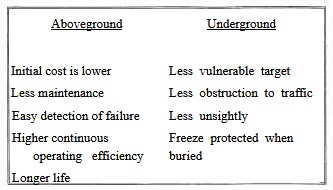An oil flow system that eliminates the need for an oil circulating pump.
COMPRESSED-AIR DISTRIBUTION
Compressed air is a powerful energy source which is very useful in military and industrial applications. It is of particular advantage in applications that require intermittent power at some distance from its source, as the air pressure can be maintained nearly constant at work intervals. The rest of this chapter will pertain to proper installation techniques of compressed-air systems. When you are assigned a project that includes compressed air lines, follow the prints and specifications.
Pressures and Uses
Compressed air usually falls into one of three categories-power service, process service, or control purposes.
Power service is when compressed air either moves something or exerts a force. Examples of power service uses are pneumatic tool operation, air lifts, clamps, and cylinders.
Process service is when compressed air is used as part of the process itself. An example is the use of compressed air in a combustion process. Compressed air provides oxygen for the combustion, and, in turn, it becomes a part of the combustion products and is no longer identifiable as air.
Control purpose is when compressed air is used to govern and/or regulate various equipment by monitoring pressure or flow rates of some substance. A pneumatically controlled combustion system is an example of such an application.
Compressed air is distributed at low, medium, or high pressure. A low-pressure system delivers air up to 125 psig. When several different pressures are required within that range, the plant is usually designed for the highest pressure. Typical low- pressure systems include the following: air motors, crane drives, starting motors for combustion engines, shops, laundry and dry-cleaning plants, and general service (tools, cleaning, painting, and soot blowing for HTW generators and steam boilers).
Medium-pressure systems deliver air from 126 to 399 psig. Normally, this type of system provides an individual compressor located near the load. Typical applications are starting diesel engines, hydraulic lifts, and retread tire molds.
High-pressure compressed air systems range from 400 to 6,000 psig. To minimize the hazard that exists with higher pressures and capacities, you can use separate compressors for each required pressure. Some applications are torpedo workshop, ammunitions depot, catapults, wind tunnel, and testing laboratories.
Piping
Distribution piping is either aboveground or underground. Both aboveground and underground piping systems have advantages and disadvantages. The advantages of each system are as follows:

Some other factors considered are permanent versus temporary use, existence of high water table, annual ownership, operation and maintenance costs, and degree of hazard (example, potential danger that overhead piping may cause to aircraft operations).
Low-pressure and medium-pressure systems use black steel pipe. Preferably the joints are welded. Special conditions may require stainless steel and copper tubing with appropriate fittings. Connections to removable equipment are always flange fittings, except when using small threaded pipe.
High-pressure systems use seamless steel pipe with butt welded fittings. Screwed fittings, when used, have their ends sealed by fillet welds and exposed pipe threads covered with weld.
Piping supports are held in place by U-shaped or similar types of hangers firmly secured to support structures. Support hangers must fit closely around the pipe, but may allow for slight movement. Aboveground pipe is pitched downward a minimum of 3 inches per 100 feet of length, in the direction of the airflow, to low points where the condensate is collected and drained through drip legs. The drip legs are at all low points, bottom of all risers, and every 200 to 300 feet from horizontally pitched pipe.
Continue Reading